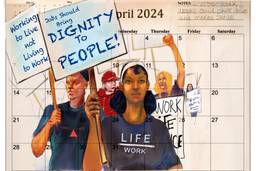As the Housing Crisis Explodes, the Trump Admin Is Quietly Undoing Its “Eviction Moratorium”
Following a pressure campaign from landlords and real estate groups, the Trump administration is giving landlords more leeway to evict tenants.
Rebecca Burns

The Trump administration has quietly walked back federal protections for renters, giving property owners more leeway to pursue eviction cases.
Last month, the Centers for Disease Control (CDC) released an unprecedented order halting most residential evictions in order to stop the spread of Covid-19. But in new guidance released Friday, the agency clarified that “eviction” just means physical removal. Landlords are still free to take tenants to court to try to get them to pay up, and even secure eviction judgements that can be carried out as soon as the CDC’s order expires January 1.
“The Order is not intended to terminate or suspend the operations of any state or local court. Nor is it intended to prevent landlords from starting eviction proceedings, provided that the actual eviction of a covered person for non-payment of rent does NOT take place during the period of the Order,” reads a “Frequently Asked Questions” posted on the CDC’s website.
The agency’s eviction ban initially appeared to prohibit landlords from filing eviction cases in court, which is often used as an intimidation tactic against tenants and can leave a black mark on their records.
The apparent weakening of the order followed a pressure campaign by landlords and real-estate trade groups nationwide, which have filed more than 25 separate lawsuits since the federal moratorium took effect September 4.
One suit, filed September 8 by a Virginia landlord in U.S. district court, argues that the CDC’s actions “are unprecedented in our history and are an affront to core constitutional limits on federal power.” The case was later joined by the National Apartment Association and is supported by the Charles Koch-backed New Civil Liberties Alliance, as reported in the Washington Post. A response in the suit, filed October 2 by attorneys for the federal government, contended that nothing in the order prevents landlords from initiating eviction suits in court — a position now affirmed in the CDC’s official guidance.
The guidance released Friday also specifies that landlords have no obligation to inform tenants of the CDC’s order, which advocates worry will create an even more unequal playing field. To be protected under the order, tenants must make a declaration to their landlord that they’ve made their best effort to pay rent and obtain government assistance, among other requirements. But it’s unclear how most tenants would know to exercise the protection.
“Landlords often belong to associations that keep them up-to-date with any changes to the law they need to know about, but it’s not like there’s a tenant e-mail list,” said Pam Bridge, director of Litigation and Advocacy at Community Legal Services, a Phoenix-based nonprofit law firm.
Bridge also noted that landlords will now be expressly permitted to challenge “the truthfulness” of a tenant’s declaration in court, which could subject them to a standard of evidence that’s difficult to meet. Documentation that tenants have tried to obtain rental assistance, for example, may be hard to come given that many local governments have awarded this assistance via lotteries where the number of applicants quickly overwhelm phone lines or online systems.
“It concerns me that this could end up being a subjective decision by judges, with every judge handling this differently,” said Bridge.
Even prior to the new guidance, three national housing rights groups — the Center for Popular Democracy, Right to the City Alliance and People’s Action — said during a press conference last week that highly uneven enforcement of the moratorium had created “mass confusion” and allowed thousands of evictions to proceed in apparent violation of the CDC’s order.
Emily Brockman, a mother of a 5-month-old in Lexington, Kentucky, recounted how she ended up in court for unpaid rent in September after losing her job as a result of the pandemic. Brockman said that she had attempted to use the CDC’s declaration to stave off eviction.
“[The judge] just looked at my landlord and said, ‘What would you like to do?’ Of course they said they would like to move forward with the eviction,” she recalled during the press conference.
“Everything happened so fast. I was shocked. I had assumed I was going to be safe under the CDC guidelines because I matched perfectly,” Brockman continued.
Brockman connected with an attorney through the Lexington Housing Justice Collective and, on the day the sheriff was supposed to show up at her house to evict her, received word that she had been granted another hearing in appeals court. The eviction order was temporarily overturned, and Brockman is now waiting for another court date in January, after the moratorium expires.
But advocates worry that the further weakening of federal protections could leave vulnerable renters exposed even sooner. The U.S. Census Bureau’s most recent Household Pulse survey found that of 58 million households, roughly one-quarter had no or only slight confidence in their ability to pay November rent. The possibility of federal rent and mortgage assistance is tied up in negotiations over another Covid-19 relief package, and the $60 billion currently on the table is far below the $100 billion that housing groups estimated was necessary to help just the lowest-income households avoid eviction.
Meanwhile, local protections for eviction are rapidly expiring. In Miami-Dade county, where unemployment claims are rising again and a state eviction moratorium expired at the end of September, eviction filings have nearly returned to their pre-pandemic rate, according to Alana Greer, director of the legal nonprofit Community Justice Project.
“Right now, the CDC order is the last line of defense,” she said.
Rebecca Burns is In These Times’ housing editor and an award-winning investigative reporter. Her work has appeared in Business Insider, the Chicago Reader, the Intercept, ProPublica Illinois and other outlets.








